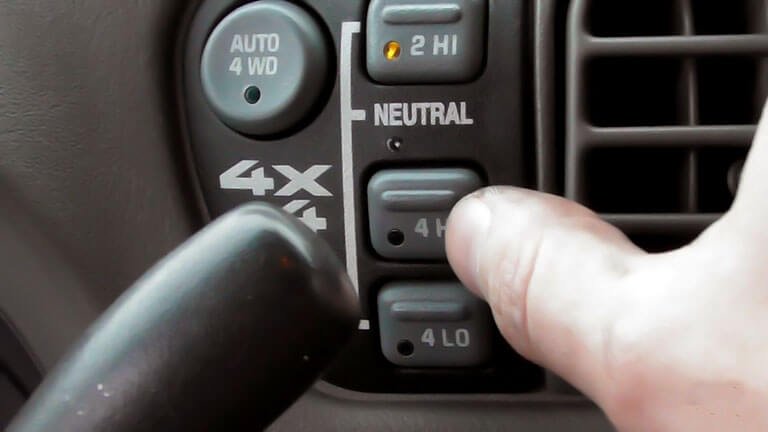Chevy Push Button 4X4 Problems: Quick Fixes & Tips
Chevy push button 4X4 problems often stem from faulty switches, wiring issues, or transfer case malfunctions. Regular maintenance helps prevent many of these issues.
Chevy trucks equipped with push-button 4X4 systems provide convenience and ease of use, but they can encounter specific problems. Drivers may experience difficulties engaging or disengaging the four-wheel drive, often due to electrical issues or worn components. Common symptoms include dashboard warning lights, grinding noises, or a complete failure to engage.
Understanding these potential pitfalls can help owners maintain their vehicles more effectively. Regular inspections and timely repairs can enhance performance and reliability. Knowing the signs of trouble is essential to address issues early and avoid costly repairs down the road. Keeping your Chevy in top shape ensures a smooth driving experience, no matter the terrain.
Introduction To Chevy’s Push Button 4×4 System

The Chevy Push Button 4X4 system offers ease and convenience. Drivers can switch between drive modes with just a press. This technology simplifies off-road adventures and everyday driving. However, some users face issues with this system.
The Innovation Behind Push Button Technology
Chevy designed the push button 4X4 system for quick access. Traditional levers are replaced by simple buttons. This innovation enhances user experience significantly.
Key features include:
- Intuitive controls: Easily switch modes.
- Quick response: Instant feedback to the driver.
- Improved safety: Less distraction while driving.
This technology reflects Chevy’s commitment to modern engineering.
Common Models Featuring This System
Many popular Chevy models come with the push button 4X4 system. Below is a table of these models:
| Model | Year |
|---|---|
| Chevy Silverado | 2015 – Present |
| Chevy Colorado | 2015 – Present |
| Chevy Tahoe | 2015 – Present |
| Chevy Suburban | 2015 – Present |
Each model features unique specifications. Users enjoy seamless transitions between 2WD and 4WD.
Typical Issues With The Push Button 4×4
The Chevy Push Button 4X4 system can face various problems. These issues can frustrate drivers. Understanding these common problems helps in troubleshooting.
Failure To Engage Or Disengage
A common problem is the system not engaging or disengaging. This issue often leaves drivers stuck in one mode. Here are some typical reasons:
- Faulty push button switch
- Defective transfer case
- Weak battery or electrical issues
Drivers may experience strange noises when trying to switch modes. This could indicate a mechanical failure. Regular maintenance can prevent these issues.
Indicator Light Malfunctions
The indicator lights may not work properly. This can confuse drivers about the current mode. Here are some common malfunctions:
| Indicator Light Issue | Possible Cause |
|---|---|
| Light stays on | Faulty sensor or wiring |
| Light blinks | Transfer case not responding |
| No light at all | Burnt-out bulb or electrical failure |
Drivers should check the owner’s manual for light indications. Ignoring these signs can lead to bigger problems.
Unresponsive System
Sometimes, the Push Button 4X4 system becomes unresponsive. This can happen suddenly and without warning. Causes may include:
- Software glitches
- Electrical shorts
- Corroded connections
In this situation, drivers should reset the system. Disconnecting the battery for a few minutes can help. If issues persist, seek professional help.
Initial Diagnostic Steps
Facing issues with your Chevy push button 4X4 can be frustrating. Start with these initial diagnostic steps. They help identify the problem quickly. Follow the steps below for effective troubleshooting.
Checking The Fuse And Relay
Fuses and relays control the 4X4 system. A blown fuse can disrupt functionality. Here’s how to check:
- Locate the fuse box. It’s usually under the dashboard or hood.
- Identify the 4X4 fuse. Check the owner’s manual for its location.
- Inspect the fuse. A broken wire means it needs replacement.
If the fuse is fine, check the relay:
- Find the relay for the 4X4 system.
- Swap it with another relay of the same type.
- Test the system again. If it works, replace the faulty relay.
Inspecting The Transfer Case Fluid Level
Low transfer case fluid can cause 4X4 issues. Follow these steps to check the fluid level:
- Park the vehicle on a level surface.
- Remove the fill plug on the transfer case.
- Stick your finger inside. Fluid should be just below the plug.
Use the following table to understand fluid types:
| Fluid Type | Recommended Use |
|---|---|
| ATF (Automatic Transmission Fluid) | For most Chevy models |
| Gear Oil | For heavier-duty applications |
Listening For Solenoid Operation Sounds
Solenoids control the engagement of the 4X4 system. Listen for operation sounds:
- Turn the ignition to the “ON” position.
- Press the 4X4 button. Listen for a click.
- If you hear no sound, the solenoid may be faulty.
Confirm the solenoid’s operation:
- Check wiring for damage or corrosion.
- Test the solenoid with a multimeter.
- Replace it if it doesn’t function properly.
Quick Fixes For Immediate Relief
Experiencing issues with your Chevy’s push button 4X4 system can be frustrating. Quick fixes can help you get back on the road faster. Below are some simple solutions to consider.
Resetting The 4×4 System
Resetting the 4X4 system may resolve minor glitches. Follow these steps:
- Turn off the engine.
- Remove the key from the ignition.
- Wait for 30 seconds.
- Reinsert the key and start the engine.
- Press the 4X4 button to engage the system.
This process often clears temporary errors. Check if the system responds correctly after the reset.
Cleaning Electrical Contacts
Dirty electrical contacts can cause problems. Follow these steps to clean them:
- Locate the 4X4 control module.
- Disconnect the battery for safety.
- Remove the electrical connectors.
- Use a contact cleaner on the connectors.
- Reattach the connectors and reconnect the battery.
Cleaning contacts can improve connectivity. It may restore proper function.
Replacing The Fuse And Relay
A blown fuse or faulty relay can disrupt the 4X4 system. Here’s how to replace them:
| Component | Steps |
|---|---|
| Fuse |
|
| Relay |
|
Replacing these components can restore functionality. Always use the correct specifications.
Advanced Troubleshooting Techniques
Troubleshooting your Chevy’s push button 4X4 system can be challenging. Proper techniques help identify the source of the problem. Use these advanced methods to ensure your vehicle operates smoothly.
Testing The Actuator
The actuator controls the 4X4 engagement. Testing it can reveal issues. Follow these steps:
- Locate the actuator. It’s usually near the transfer case.
- Disconnect the electrical connector.
- Use a multimeter to check for voltage.
- Actuate the switch while measuring voltage.
If you detect no voltage, the problem lies in the wiring or switch. If voltage is present, the actuator might be faulty.
Diagnosing Electrical Wiring Issues
Electrical problems can cause 4X4 failures. Check the wiring using these techniques:
- Inspect for damaged wires. Look for frays or breaks.
- Check all connections. Ensure they are tight and clean.
- Test continuity using a multimeter.
Refer to the table below for common wiring issues:
| Issue | Symptoms | Solution |
|---|---|---|
| Frayed wires | Intermittent 4X4 engagement | Replace the damaged sections |
| Corroded connections | No response from the system | Clean or replace connectors |
| Short circuits | Blown fuses | Locate and repair shorts |
Seeking Professional Diagnostic Tools
Sometimes, advanced tools are necessary. Professionals use specific equipment to diagnose issues. Consider these tools:
- OBD-II scanner: Reads error codes.
- Digital multimeter: Measures voltage and continuity.
- Wiring diagram: Shows correct connections.
These tools can save time and frustration. They provide accurate diagnostics for your Chevy’s 4X4 system.
Preventive Maintenance Tips
Maintaining your Chevy’s push-button 4X4 system is crucial. Regular care prevents problems. Here are some effective tips to ensure smooth operation.
Regular Fluid Checks And Changes
Fluid quality affects your 4X4 system’s performance. Follow these steps:
- Check transmission fluid every 30 days.
- Inspect transfer case fluid every 6 months.
- Change fluids based on manufacturer recommendations.
Use high-quality fluids for best results. Poor fluid quality can lead to system failure.
System Use Recommendations
Using your 4X4 system properly extends its life. Keep these tips in mind:
- Engage 4X4 system in low traction situations.
- Avoid using 4X4 on dry pavement.
- Switch back to 2WD when conditions improve.
Regular use of the system keeps components lubricated. This prevents rust and wear.
Scheduled Professional Inspections
Professional checks catch issues early. Schedule inspections every 12 months. During inspections, professionals will:
| Inspection Area | Importance |
|---|---|
| Electrical connections | Ensure proper communication between components. |
| Actuators | Verify engagement and disengagement functions. |
| Fluid levels | Check for leaks and proper fluid levels. |
Regular inspections save money on costly repairs. Stay proactive to enjoy smooth rides.
Real-world Solutions From Chevy Owners
Chevy owners face various problems with the push button 4X4 system. The good news? Many have shared their real-world solutions. Their experiences provide insight and hope for others.
Community Forum Highlights
Many Chevy owners discuss their issues online. Here are some common themes:
- Button Malfunction: Owners report buttons not responding.
- Engagement Issues: 4X4 not engaging or disengaging.
- Warning Lights: Dashboard lights indicating problems.
Forums like ChevyTalk and GM-Trucks are valuable resources. Users often share troubleshooting tips and experiences.
Success Stories
Many Chevy owners found effective solutions. Here are some inspiring success stories:
- Simple Reset: One owner reset the system by disconnecting the battery. This fixed the button issue.
- Sensor Replacement: Another owner replaced a faulty sensor. This resolved the engagement problem.
- Software Update: A few users updated their vehicle’s software. This improved overall performance.
These stories show that solutions often come from simple fixes.
Creative Fixes That Worked
Some owners took matters into their own hands. Here are some creative fixes:
| Owner’s Idea | Description |
|---|---|
| DIY Wiring Check | Owners checked wiring connections for loose or damaged wires. |
| Button Replacement | Replacing the push button with a more reliable switch. |
| Manual Override | Creating a manual switch to control 4X4 engagement. |
These creative solutions highlight the resourcefulness of Chevy owners. They prove that sometimes, the best fixes come from community collaboration.
When To Seek Professional Help
Understanding when to seek professional help for your Chevy Push Button 4X4 issues is crucial. Some problems are simple, while others require expert knowledge. Ignoring complex issues can lead to bigger problems later.
Recognizing Complex Electrical Faults
Electrical faults often cause significant issues in the Chevy Push Button 4X4 system. Recognizing these faults early can save time and money. Here are some signs to watch for:
- Inconsistent engagement: The system fails to engage or disengage smoothly.
- Warning lights: Dashboard lights indicate a malfunction.
- Unusual noises: Grinding or clicking sounds when activating 4X4.
These symptoms suggest complex electrical issues. They may involve wiring, sensors, or control modules.
Benefits Of Authorized Dealer Services
Choosing authorized dealer services offers several advantages:
| Benefit | Description |
|---|---|
| Expert Technicians | Trained professionals with specific knowledge of Chevy systems. |
| OEM Parts | Guaranteed quality with Original Equipment Manufacturer parts. |
| Warranty Protection | Repairs often come with warranties for peace of mind. |
Finding A Trusted Mechanic
Finding a reliable mechanic can make a difference. Look for the following:
- Experience: Choose a mechanic with experience in Chevy vehicles.
- Reviews: Check online reviews and ratings from other customers.
- Certifications: Verify certifications and training in automotive repair.
Trustworthy mechanics ensure proper diagnosis and repairs. This helps keep your Chevy Push Button 4X4 in top shape.
Frequently Asked Questions
What Are Common Chevy Push Button 4×4 Issues?
Common issues include malfunctioning switches, poor connectivity, and system resets that disrupt 4X4 engagement.
How Can I Troubleshoot 4×4 Problems?
Start by checking the fuse, inspecting the switch, and ensuring the transfer case is functioning properly.
Why Is My 4×4 Light Flashing?
A flashing 4X4 light usually indicates a malfunction in the system or an issue with the transfer case.
Can I Fix Push Button 4×4 Issues Myself?
Many minor issues can be resolved at home, but complex problems may require professional assistance.
When Should I Seek Professional Help For 4×4?
Consult a mechanic if troubleshooting doesn’t resolve the issue or if you notice unusual noises or performance drops.
Conclusion
Chevy push button 4X4 systems can present various challenges. Understanding these issues is essential for effective troubleshooting and maintenance. Regular checks can prevent major problems down the line. Stay informed about your vehicle’s needs to ensure a smooth driving experience.
Addressing these concerns early can save time and money in the long run.






